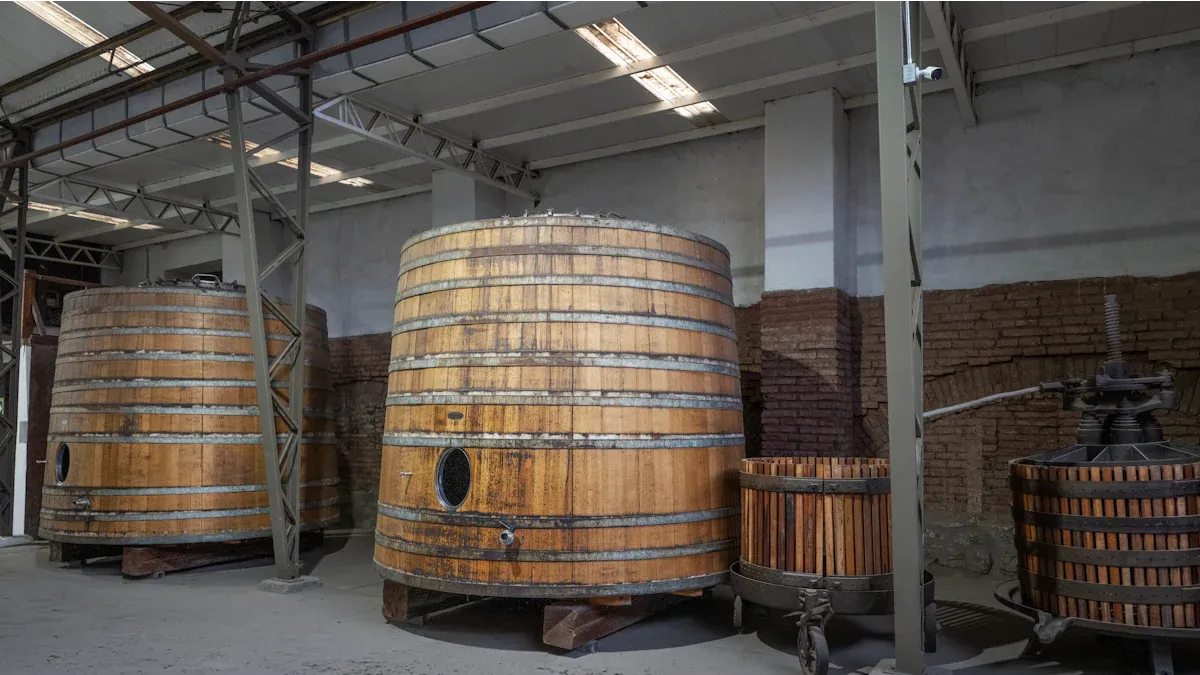
Wine Making Vats Longevity Guide for 2025
Maintain wine making vats for longevity in 2025 with cleaning, inspections, and proper care to ensure optimal wine quality and extend vat lifespan.

Maintain wine making vats for longevity in 2025 with cleaning, inspections, and proper care to ensure optimal wine quality and extend vat lifespan.

Table of Contents Beer Fermentation Tank Wine Fermentation Tank Fermentation Microorganisms Are Different The Brewing Process Is Different Different Temperatures Are Required Fermentation Tanks Are Designed Understanding the fundamental differences between beer and wine fermentation tanks is crucial for beverage producers looking to optimize their production processes. While both serve the essential function of converting sugars into alcohol, beer and wine fermenters vary significantly in design, operation, and specifications. This comprehensive guide explores the key distinctions in tank construction, fermentation processes, temperature requirements, and design considerations that make each fermenter type uniquely suited to its specific beverage production needs. Beer Fermentation Tank Beer fermentation tanks, commonly known as fermenters or FVs (fermentation vessels), are specifically engineered to handle the unique requirements of beer production. These vessels typically feature conical bottom designs that facilitate yeast collection and removal, making them essential for maintaining beer clarity and quality. Modern beer fermenters are predominantly constructed from stainless steel, offering superior durability, easy cleaning, and excellent temperature control capabilities. Top beer fermentation tanks for breweries incorporate advanced features like pressure rating capabilities, sample ports, and integrated cooling systems. The typical beer fermenter operates under controlled pressure conditions, often ranging from 0.5 to 2.0 bar,

Table of Contents Basic Process of Whiskey Brewing Types of Distilling Equipment Required for Distilling Distilleries How to Choose Whiskey Brewing Equipment? Whiskey Distilling Equipment Maintenance Frequently Asked Questions Setting up a whiskey distillery requires careful selection of specialized distilling equipment that ensures quality production and operational efficiency. From fermentation tanks to sophisticated distillation columns, each component plays a crucial role in creating premium whiskey. This comprehensive guide explores the essential equipment needed for whiskey distillation, helping distillery owners make informed decisions about their investment in brewing infrastructure. Basic Process of Whiskey Brewing Understanding the whiskey production process is fundamental before investing in distilling equipment. The whiskey brewing process involves several critical stages, each requiring specific equipment for optimal results. The journey begins with mashing, where grains are combined with hot water to convert starches into fermentable sugars. This process requires a mash tun with precise temperature control capabilities. Following mashing, the wort (liquid containing dissolved sugars) undergoes fermentation, where yeast converts sugars into alcohol and carbon dioxide. Process Stage Duration Key Equipment Temperature Range Mashing 2-4 hours Mash Tun 60-70°C Fermentation 3-7 days Fermentation Tanks 25-32°C First Distillation 6-8 hours Wash Still 78-100°C Second Distillation 4-6 hours Spirit Still

Setting up a successful distillery requires careful selection of specialized distillation equipment designed to transform raw materials into high-quality spirits. From mash tanks and fermentation vessels to sophisticated stills and condensers, each component plays a crucial role in the distillation process. This comprehensive guide explores essential distillation equipment, their applications across various industries, and key factors to consider when selecting equipment for your distillery operation. Table of Contents What is distillation equipment? Application of distillation equipment What equipment is needed for a distillery? How to choose distillation and brewing equipment? In the world of modern distillery operations, understanding the fundamental equipment requirements is essential for producing high-quality spirits. Establishing a successful distillery requires a comprehensive understanding of the specialized equipment necessary for transforming raw materials into exceptional alcoholic beverages. The distillation process involves multiple interconnected stages, each requiring specific equipment designed to handle the unique challenges of spirit production. From initial mashing and fermentation to final distillation and storage, every piece of equipment must work in harmony to create exceptional products. Modern distilleries rely on advanced stainless steel equipment that ensures product quality, operational efficiency, and regulatory compliance. The selection of appropriate distillation equipment directly impacts production capacity, product consistency,

Understanding the distinction between fermentation tanks and bright tanks is crucial for any brewery operation. While fermentation tanks handle the primary brewing process where yeast converts sugars into alcohol, bright tanks serve as conditioning vessels for clarification, carbonation, and storage before packaging. This comprehensive guide explores their unique functions, advantages, and selection criteria to help you optimize your brewing operations. Table of Contents What is a fermentation tank? Advantages of Fermentation Tanks What is a Bright Tank? Bright Tank Features How do bright tanks work? How to choose between fermentation tanks and bright tanks? FAQ In the world of brewing, understanding the fundamental differences between fermentation tanks and bright tanks is essential for producing high-quality beverages. These two types of vessels serve distinct yet complementary roles in the brewing process, each designed for specific stages of production. Fermentation tanks are the workhorses of primary fermentation, where the magic of converting sugars into alcohol occurs. Bright tanks, on the other hand, serve as conditioning and storage vessels that prepare the finished product for packaging. The choice between these tanks depends on your production scale, product type, and quality requirements. What is a fermentation tank? A fermentation tank is a specialized vessel

Maintain wine making vats for longevity with cleaning, inspections, and proper storage to protect wine quality and extend vat lifespan.